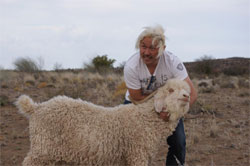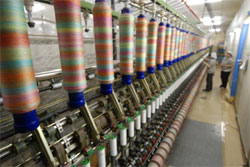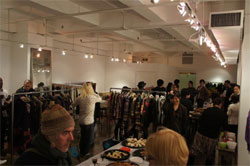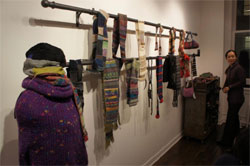Reports and Statistics
Survey Reports
June 2012
Challenge! International Business - Original Knitwear from Yamagata to the World: Sato Seni Co., Ltd.
Sato Seni provides high-quality knitting yarn to fashion brand names all over the world. Committed to quality manufacturing, the company deals with the production of raw materials (yarn) as well as the manufacturing and sales of the products (knitwear). It has also introduced its own brand to countries around the world. Let’s take a look at the company’s business strategy which sets itself apart from large-scale apparel manufacturers.
Creating something entirely original
It was in January 2009 at the inauguration in the U.S. Capitol Washington D.C. Standing by President Obama was First Lady Michelle, wearing a light yellow knitted cardigan. It was unusual to spot anyone wearing a knit garment in a formal occasion like this. The cardigan caught the attention of the textile industry. Sato Seni was the company that provided the yarn for her sweater.
Sagae City in Yamagata Prefecture ranks third in Japan in the production of women’s knitwear. Sato Seni set up a factory in this area and started off as a spinnery in 1932.
After working at an apparel manufacturer in Tokyo, Masaki Sato, who later became the fourth and current president of Sato Seni, returned to his home town in 1992. This was the time when cheap materials and products from China and other countries had started pouring into the Japanese market, significantly affecting the demand for local products. Many companies in the spinnery business, which once exceeded 300 in number, went out of business or left the town. Sato felt that, in order to survive, it was necessary to not only function as a supplier to manufacturers, but also invent and release original products that set you apart from others. However, he knew that it was risky for a small company like Sato Seni to deal with trendy products that the world pursued. This was because they would end up in a price competition against big companies and lose the bid.
Sato started to work on creating yarn that nobody had seen before and developing knitwear using such special yarn. He persuaded his employees that were skeptical of the success of the new project. Extensive research was conducted. He even visited yarn-making factories and trade shows in Italy, famous for its yarn production. Using a spinning machine in which slight modifications were made, the company successfully created one strand of colorful yarn by spinning yarn of various colors and thicknesses. It was Sato Seni’s exclusive yarn that had not existed before. With the help of Mrs. Sato, who was a knitwear designer, the company decided to produce original knit garments using this yarn.

Mr. Masaki Sato, President, Sato Seni

Japan hears of the reputation in the U.S. market
With confidence, Sato Seni created original knitwear using its exclusively developed yarn. However, none of the retail stores showed interest in carrying the products, considering them as something made out of a “factory.” What was lacking was the brand power. Looking at inventory that kept piling up, Sato himself loaded a truck with the products from time to time to sell them as clearance items to customers in Yamagata.
In a situation that seemed like there was no way out, Sato had a revelation. “We need to showcase the products.” The turning point came when Sato Seni participated in an apparel exhibition in Tokyo in 2000. One of the buyers that Sato met at the event invited him to participate in a trade show in New York. “We need to increase the product value by selling our brand-name products in a market that truly appreciates good fashion.” Sato decided to take part in the exhibition. The brand “M.&KYOKO,” which was derived by combining the first names of Mr. and Mrs. Sato, was released in 2001.
“How should the products be promoted so they emotionally move the buyers of another country?” Back then in the U.S., black was the popular color. In spite of the trend, Sato Seni featured colorful knitwear that represented the company identity at the trade show. The booth was given a natural and pure look to go in line with the product’s quality. The clothes were displayed on hangers hung on tree branches and the entire booth was adorned with white cotton fabric. “We are a company that has been in the spinning business for 100 years in a snow-deep region in Japan. This brand was created by the fourth owner Masaki and his wife….” They told the story behind the products to the buyers that came to the booth. Sato believed that Americans have some sort of yearning toward tradition because they do not have much of a history compared to other countries. Just as he thought, the buyers were very attracted to the story as well as the products themselves.
Following the successful trade show, Sato continued to travel all over the U.S. to steadily secure clients. The textile industry in Japan eventually heard about the brand and its reputation. The products ended up being imported back and getting featured on a shopping channel in Japan with great success. The solid status in the U.S. helped the company move its business forward in Japan.


Showroom in central New York
Yarn chosen by a famed brand
Around 2001, just when the M.&KYOKO brand started to take off, Sato began looking into sources for the raw materials for yarn to create products that he had in mind. He visited Peru, Australia and Mongolia and traveled to countries around the world that were famous for wool. In 2005, he encountered mohair obtained from the hair of Angora goats in South Africa and was captivated by its high luster and sheen. However, one downside of mohair was that it could be itchy. In order to resolve that issue, the company chose an old spinning machine that goes back half a century which allows for the subtle adjustment of the toothed wheels. With this machine, the fiber could be drawn out to 52 meters per gram instead of 13 meters with the new one. This led to the development of ultrathin mohair yarn that was soft as silk.
In 2007, the company became the exhibitor at Pitti Immagine Filati, the world’s leading trade show held in Italy showcasing yarn. Ultrathin mohair yarn was a hit among the buyers. The following year, Sato Seni secured a booth on the main floor where there was most foot traffic. Buyers showed up one after another and in no time at all Sato Seni received orders from 120 companies. However, the happy moments did not last very long. In September 2008, a couple of months after the trade show, the Lehman shock hit the world markets, causing the euro to collapse. Almost all the orders were canceled because the buyers could not afford it anymore.
When Sato was about to give up on the international market, he received one email. “I heard you have something very unique.” The message was from a Chanel buyer in France that heard about Sato Seni’s high-quality yarn. Sato immediately responded by sending out an abundance of samples to Chanel. The following year in January 2009, Chanel surprised everyone at the fashion show of its new collection. About 60% of the clothing was knitwear, most of which used Sato Seni’s yarn. Sato’s strong faith in his company’s own brand in terms of its quality and pricing turned into a reality.
Hearing that Chanel is dealing with Sato Seni, a number of brands from other countries started to place orders. In the past, plain colors were often seen at knitwear trade shows worldwide. However, the tendency now is to showcase knit products using yarn of various colors. Sato is proud of his company’s accomplishments. “I believe we brought a big impact on the industry trend. Even a small manufacturer like us can make a difference in the world.”
In January 2012, Sato Seni participated in the Tohoku Regional Textiles/Knits Manufacturer Tradeshow held in Manhattan, New York. The event was sponsored by JETRO and was organized for businesses operating in the disaster-affected areas. It connected Sato Seni with many dominant buyers. In the following month, Sato Seni opened a showroom in central New York to create a sales base for yarn and knitwear in the U.S. Currently there are nine retail stores in Japan that are managed directly by the company. Sato Seni is planning on setting up company stores in New York, Paris and Shanghai as well. Foreseeing the bright future of local brands and new designers in China, the company participated in the Shanghai Spin Expo held in 2011. It is also in the process of marketing original yarn in China, including wool that does not lose its luster even after washing. “It is possible that we start supplying yarn through OEM (original equipment manufacturer) partnerships with Chinese companies.” Sato is optimistic about the opportunities ahead.
As the head of the company, Sato tirelessly travels all over the world for business meetings. He takes pride that his company manages all operations, ranging from the production of yarn to manufacturing of the end products. The specifications and designs of each product are all determined in-house. “Just like Apple did with its value-added software development, we must continue to explore aspects of our business that bring in profit.” It is not a far-fetched scenario that the trend originating in Yamagata would soon take up the world’s knit industry by storm.
Soichi Umeki
JETRO Yamagata
Foundation: 1932
CEO: Masaki Sato
Capital: 54.1 million yen
Head Office: 1-19-1 Motomachi Sagae, Yamagata, Japan
Scope of Business: Production of worsted spun yarn and knitwear
Number of Employees: 184
Sales: 2.7 billion yen (group as a whole)
Website: http://www.satoseni.com/



